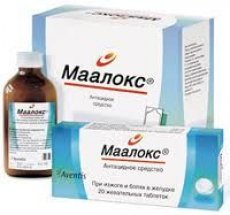Medical expert of the article
New publications
Preparations
Maalox
Last reviewed: 03.07.2025

All iLive content is medically reviewed or fact checked to ensure as much factual accuracy as possible.
We have strict sourcing guidelines and only link to reputable media sites, academic research institutions and, whenever possible, medically peer reviewed studies. Note that the numbers in parentheses ([1], [2], etc.) are clickable links to these studies.
If you feel that any of our content is inaccurate, out-of-date, or otherwise questionable, please select it and press Ctrl + Enter.

Indications Maalox
The antacid-adsorbing effect determines the main indications for the use of Maalox, which include:
- acute and chronic inflammation of the gastric mucosa against the background of increased acidity ( gastritis, peptic ulcer );
- acute and chronic inflammation of the mucous membrane of the duodenum ( duodenitis );
- acute and chronic inflammation of the pancreas ( pancreatitis );
- heartburn associated with repeated reflux of stomach contents into the esophagus ( reflux esophagitis );
- pylorospasm and pyloroduodenal stenosis, accompanied by an increase in the acidity of gastric juice.
Release form
The drug is available in the following forms: chewable tablets, suspension for oral administration (in 250 ml bottles and in sachets).
Pharmacodynamics
The pharmacodynamics of Maalox is determined by the action of the substances that are part of its composition - aluminum hydroxide and magnesium hydroxide (in equal quantities). When entering the stomach, these substances enter into a chemical reaction with free hydrochloric acid of the gastric juice and neutralize it with the formation of salts - aluminum and magnesium chlorides - and water.
Maalox increases the hydroxide ion content (pH) in gastric juice, and this effect is maintained for several hours, blocking the effect of acid on the gastric mucosa. But the natural digestion process is not disrupted, and no additional hydrochloric acid is produced.
Aluminum and magnesium oxides also bind bile acids entering the stomach, preventing the mucous membrane from being destroyed. In addition, after a certain time, magnesium chloride entering the intestines begins to act as a laxative - by increasing the pressure in the intestinal lumen and increasing its contractions. However, the laxative effect is insignificant, since aluminum weakens the activity of magnesium.
Pharmacokinetics
The pharmacokinetics of Maalox are characterized by the absence of systemic effects, provided that the drug is used in recommended doses, since aluminum chloride and magnesium chloride are almost not absorbed in the stomach and do not enter the bloodstream.
The removal of end products from the body occurs through the intestines (with feces). At the same time, the concentration of phosphates in the blood decreases, since these substances bind phosphates in the stomach and intestines and also remove them from the body.
Dosing and administration
The drug Maalox in tablet form is prescribed 1-2 tablets (chewed) - 1.5 hours after eating or when heartburn occurs. In case of gastric ulcer, tablets are taken half an hour before eating. After achieving the therapeutic effect, Maalox suspension is usually taken an hour after eating - one tablespoon (or the contents of one packet).
Use Maalox during pregnancy
The use of Maalox during pregnancy has not been sufficiently studied due to the lack of clinical data, although no pronounced teratogenic effects of Maalox during pregnancy have been identified. Therefore, the use of Maalox during pregnancy is permissible only when its expected benefit to the mother outweighs the potential threat to the fetus. At the same time, it is absolutely unacceptable to prescribe large doses of this drug or to use it for a long time.
Contraindications
Contraindications to the use of Maalox include: increased individual sensitivity to the drug, severe kidney pathologies, Alzheimer's disease, low serum phosphate levels (hypophosphatemia), constipation and intestinal obstruction, children under 12 years of age, and lactation in women.
 [ 13 ]
[ 13 ]
Side effects Maalox
Possible side effects of Maalox include nausea, vomiting, diarrhea or constipation, and taste disturbances.
In the presence of renal failure, magnesium chloride can enter the blood, which leads to a feeling of thirst, a decrease in blood pressure and depression of the central nervous system (in the form of a decrease in the severity of reflexes and dementia).
Side effects of Maalox in cases of its long-term use in significant doses are associated with impaired renal function, increased levels of calcium in the urine and aluminum in the blood plasma, deficiency of phosphorus and calcium in the body, and osteoporosis.
Overdose
Overdosage of this drug has not been recorded by the manufacturers.
 [ 20 ]
[ 20 ]
Interactions with other drugs
Maalox interactions with other drugs include a reduction in the therapeutic effect of tetracycline antibiotics, quinolone antibacterial drugs (fluoroquinolone derivatives), salicylates and glucocorticoids.
Concomitant use of Maalox may also reduce the absorption and effects of certain anticoagulants, antihistamines, adrenolytic drugs (beta-blockers) and sleeping pills.
Attention!
To simplify the perception of information, this instruction for use of the drug "Maalox" translated and presented in a special form on the basis of the official instructions for medical use of the drug. Before use read the annotation that came directly to medicines.
Description provided for informational purposes and is not a guide to self-healing. The need for this drug, the purpose of the treatment regimen, methods and dose of the drug is determined solely by the attending physician. Self-medication is dangerous for your health.

